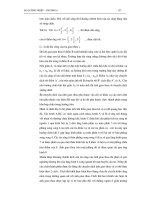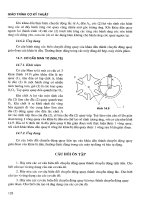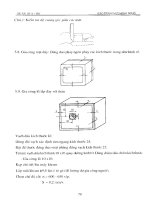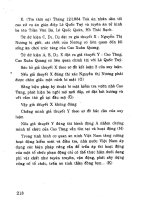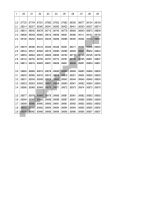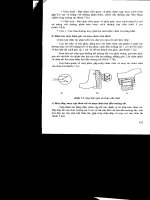Giáo trình C++ - Ngành CNTT - Part 10
Bạn đang xem bản rút gọn của tài liệu. Xem và tải ngay bản đầy đủ của tài liệu tại đây (2.59 MB, 85 trang )
Copyright © 2007 Pearson Education, Inc. Publishing as Pearson Addison-Wesley
Chapter 10
Defining Classes
Slide 10- 3
Copyright © 2007 Pearson Education, Inc. Publishing as Pearson Addison-Wesley
Overview
10.1 Structures
10.2 Classes
10.3 Abstract Data Types
Copyright © 2007 Pearson Education, Inc. Publishing as Pearson Addison-Wesley
10.1
Structures
Slide 10- 5
Copyright © 2007 Pearson Education, Inc. Publishing as Pearson Addison-Wesley
What Is a Class?
A class is a data type whose variables are objects
Some pre-defined classes you have used are
int
char
ifstream
You can define your own classes as well
Slide 10- 6
Copyright © 2007 Pearson Education, Inc. Publishing as Pearson Addison-Wesley
Class Definitions
A class definition includes
A description of the kinds of values the variable
can hold
A description of the member functions
We will start by defining structures as a first
step toward defining classes
Slide 10- 7
Copyright © 2007 Pearson Education, Inc. Publishing as Pearson Addison-Wesley
Structures
A structure can be viewed as an object
Contains no member functions
(The structures used here have no member functions)
Contains multiple values of possibly different types
The multiple values are logically related as a single item
Example: A bank Certificate of Deposit (CD)
has the following values:
a balance
an interest rate
a term (months to maturity)
Slide 10- 8
Copyright © 2007 Pearson Education, Inc. Publishing as Pearson Addison-Wesley
The Certificate of Deposit structure can be
defined as
struct CDAccount
{
double balance;
double interest_rate;
int term; //months to maturity
};
Keyword struct begins a structure definition
CDAccount is the structure tag or the structure’s type
Member names are identifiers declared in the braces
The CD Definition
Remember this semicolon!
Slide 10- 9
Copyright © 2007 Pearson Education, Inc. Publishing as Pearson Addison-Wesley
Using the Structure
Structure definition is generally placed outside
any function definition
This makes the structure type available to all code
that follows the structure definition
To declare two variables of type CDAccount:
CDAccount my_account, your_account;
My_account and your_account contain distinct
member variables balance, interest_rate, and term
Slide 10- 10
Copyright © 2007 Pearson Education, Inc. Publishing as Pearson Addison-Wesley
The Structure Value
The Structure Value
Consists of the values of the member variables
The value of an object of type CDAccount
Consists of the values of the member variables
balance
interest_rate
term
Slide 10- 11
Copyright © 2007 Pearson Education, Inc. Publishing as Pearson Addison-Wesley
Specifying Member Variables
Member variables are specific to the
structure variable in which they are declared
Syntax to specify a member variable:
Structure_Variable_Name . Member_Variable_Name
Given the declaration:
CDAccount my_account, your_account;
Use the dot operator to specify a member variable
my_account.balance
my_account.interest_rate
my_account.term
Slide 10- 12
Copyright © 2007 Pearson Education, Inc. Publishing as Pearson Addison-Wesley
Member variables can be used just as any other
variable of the same type
my_account.balance = 1000;
your_account.balance = 2500;
Notice that my_account.balance and your_account.balance
are different variables!
my_account.balance = my_account.balance + interest;
Display 10.1 (1)
Display 10.1 (2)
Display 10.2
Using Member Variables
Slide 10- 13
Copyright © 2007 Pearson Education, Inc. Publishing as Pearson Addison-Wesley
Back
Next
Display 10.1 (1/2)
Slide 10- 14
Copyright © 2007 Pearson Education, Inc. Publishing as Pearson Addison-Wesley
Back
Next
Display 10.1
(2/2)
Slide 10- 15
Copyright © 2007 Pearson Education, Inc. Publishing as Pearson Addison-Wesley
Back
Next
Display 10.2
Slide 10- 16
Copyright © 2007 Pearson Education, Inc. Publishing as Pearson Addison-Wesley
Member variable names duplicated between
structure types are not a problem.
super_grow.quantity and apples.quantity are
different variables stored in different locations
struct FertilizerStock
{
double quantity;
double nitrogen_content;
};
FertilizerStock super_grow;
struct CropYield
{
int quantity;
double size;
};
CropYield apples;
Duplicate Names
Slide 10- 17
Copyright © 2007 Pearson Education, Inc. Publishing as Pearson Addison-Wesley
Structures as Arguments
Structures can be arguments in function calls
The formal parameter can be call-by-value
The formal parameter can be call-by-reference
Example:
void get_data(CDAccount& the_account);
Uses the structure type CDAccount we saw earlier as the type for
a call-by-reference parameter
Slide 10- 18
Copyright © 2007 Pearson Education, Inc. Publishing as Pearson Addison-Wesley
Structures as Return Types
Structures can be the type of a value returned by
a function
Example:
CDAccount shrink_wrap(double the_balance,
double the_rate,
int the_term)
{
CDAccount temp;
temp.balance = the_balance;
temp.interest_rate = the_rate;
temp.term = the_term;
return temp;
}
Slide 10- 19
Copyright © 2007 Pearson Education, Inc. Publishing as Pearson Addison-Wesley
Using Function shrink_wrap
shrink_wrap builds a complete structure value
in temp, which is returned by the function
We can use shrink_wrap to give a variable of
type CDAccount a value in this way:
CDAccount new_account;
new_account = shrink_wrap(1000.00, 5.1, 11);
Slide 10- 20
Copyright © 2007 Pearson Education, Inc. Publishing as Pearson Addison-Wesley
Assignment and Structures
The assignment operator can be used to assign
values to structure types
Using the CDAccount structure again:
CDAccount my_account, your_account;
my_account.balance = 1000.00;
my_account.interest_rate = 5.1;
my_account.term = 12;
your_account = my_account;
Assigns all member variables in your_account the
corresponding values in my_account
Slide 10- 21
Copyright © 2007 Pearson Education, Inc. Publishing as Pearson Addison-Wesley
Structures can contain member variables that are also
structures
struct PersonInfo contains a Date structure
struct Date
{
int month;
int day;
int year;
};
struct PersonInfo
{
double height;
int weight;
Date birthday;
};
Hierarchical Structures
Slide 10- 22
Copyright © 2007 Pearson Education, Inc. Publishing as Pearson Addison-Wesley
Using PersonInfo
A variable of type PersonInfo is declared by
PersonInfo person1;
To display the birth year of person1, first access the
birthday member of person1
cout << person1.birthday…
But we want the year, so we now specify the
year member of the birthday member
cout << person1.birthday.year;
Slide 10- 23
Copyright © 2007 Pearson Education, Inc. Publishing as Pearson Addison-Wesley
A structure can be initialized when declared
Example:
struct Date
{
int month;
int day;
int year;
};
Can be initialized in this way
Date due_date = {12, 31, 2004};
Initializing Classes
Slide 10- 24
Copyright © 2007 Pearson Education, Inc. Publishing as Pearson Addison-Wesley
Section 10.1 Conclusion
Can you
Write a definition for a structure type for records consisting of a
person’s wage rate, accrued vacation (in whole days), and status
(hourly or salaried). Represent the status as one of the two
character values ‘H’ and ‘S’. Call the type EmployeeRecord.
Copyright © 2007 Pearson Education, Inc. Publishing as Pearson Addison-Wesley
10.2
Classes
